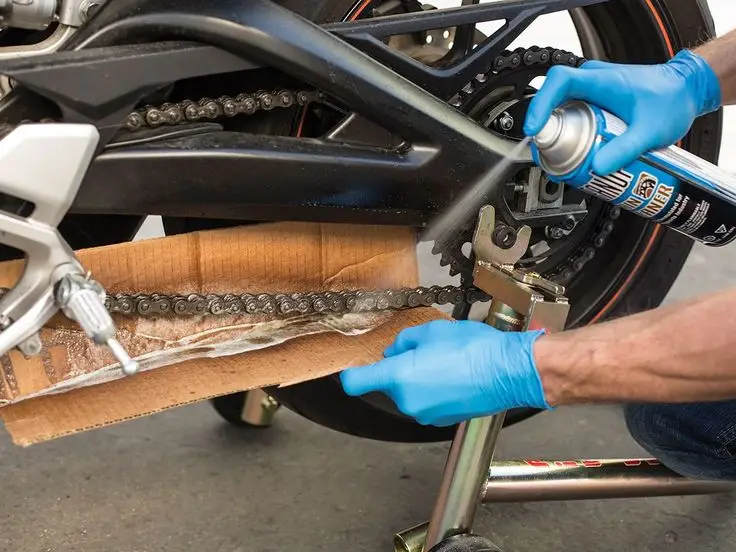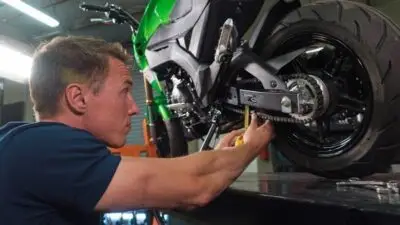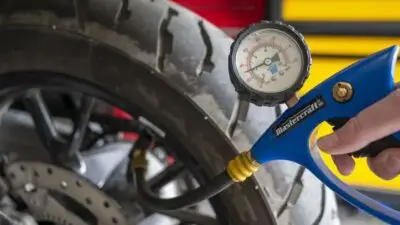Taking care of your motorcycle chain isn’t just about extending its life—it’s about your safety and performance too. Regular cleaning and lubrication of your motorcycle chain prevents premature wear, reduces the risk of chain failure, and improves your bike’s overall performance. Many riders skip this essential maintenance task or don’t do it correctly, which can lead to costly repairs down the road.

The process doesn’t need to be complicated. You’ll need to raise the rear wheel off the ground, apply a good degreaser with a chain brush to remove built-up grime, and then apply a thin coat of quality chain lubricant. It’s important to examine your chain and sprockets before you start to check for any damage that might require professional attention.
Key Takeaways
- Regular chain maintenance prevents premature wear and improves motorcycle safety and performance.
- Clean your chain with appropriate tools and degreaser before applying a thin coat of lubricant.
- Different riding conditions require specific lubrication products and maintenance schedules for optimal chain protection.
Why Proper Chain Maintenance Is Crucial

Regular chain maintenance directly affects your motorcycle’s performance, longevity, and your safety on the road. Taking care of this critical component prevents costly repairs and dangerous situations while ensuring optimal power transfer from engine to wheel.
Impact on Motorcycle Performance
A properly maintained motorcycle chain delivers power efficiently from the engine to the rear wheel. When chains become dirty or inadequately lubricated, they create drag and resistance in the drivetrain. This resistance wastes engine power and reduces acceleration and fuel economy.
Dirt and grime between chain links cause the chain to bind and move less freely. This binding creates inconsistent power delivery, causing jerky acceleration or hesitation when throttling.
Many riders notice a significant difference in smoothness after cleaning and lubricating their chain. The bike responds more predictably to throttle inputs and operates more quietly.
Poor chain maintenance also leads to uneven wear on sprockets, further reducing performance and potentially causing chain skipping under heavy loads.
Extending Chain Lifespan
Motorcycle chains aren’t cheap components. Regular maintenance dramatically extends their useful life, saving you money and preventing inconvenient breakdowns.
A neglected chain wears out much faster than a properly maintained one. Sealed chains lose lubrication over time, requiring regular maintenance to prevent drying out, cracking, and falling apart.
Key maintenance tasks that extend chain life:
- Regular cleaning to remove abrasive dirt
- Proper lubrication to reduce friction
- Maintaining correct tension
- Prompt adjustment when needed
Without these basic maintenance steps, chains can wear out in as little as 5,000 miles. With proper care, many chains last 20,000 miles or more—a significant difference in longevity and value.
Enhancing Rider Safety
A broken or severely worn chain creates serious safety hazards. When chains fail during operation, they can:
- Lock the rear wheel, causing loss of control
- Whip around violently, damaging other components
- Leave you stranded in potentially dangerous locations
Routine maintenance checks help identify potential problems before they become critical failures. Inspecting for tight spots, kinks, or excessive stretch allows you to replace the chain before it fails unexpectedly.
Chain maintenance also indirectly impacts safety through performance. A properly maintained drivetrain provides predictable power delivery when you need it most—such as when passing or avoiding road hazards.
Simple preventative care dramatically reduces the likelihood of chain-related accidents and stranding incidents.
Gathering the Right Cleaning and Lubrication Tools

Proper chain maintenance requires specific tools and products designed to clean away grime and provide lasting lubrication. Having the right supplies on hand makes the job easier and ensures better results for your motorcycle.
Essential Cleaning Supplies
A good chain cleaning routine starts with the right cleaning agents. Many riders use a dedicated motorcycle degreaser specifically formulated for chains. These products break down tough grease and road grime effectively.
Some riders prefer traditional options like kerosene or mineral spirits, which work well for removing stubborn chain buildup. These solvents cut through grease quickly but require careful handling due to their flammable nature.
For application, you’ll need:
- Chain cleaning brush or tool
- Old toothbrush (for tight spots)
- Clean rags or shop towels
- Rubber gloves to protect your hands
- Cardboard or plastic sheet to catch drips
WD-40 can be used as a cleaning agent, though some experts recommend dedicated degreasers for better results. A chain cleaning tool that wraps around the chain can make the process more efficient.
Recommended Lubricants and Products
After cleaning, applying the right chain lube is crucial for extending chain life. Choose lubricants based on your riding conditions:
| Riding Conditions | Recommended Lube Type |
|---|---|
| Dry/Dusty | Dry or wax-based lube |
| Wet/Rainy | Heavy-duty wet lube |
| All-Purpose | Ceramic or PTFE lube |
Quality brands make a difference in how well the lube adheres and protects. Products like Chain-L offer excellent longevity between applications.
For riders wanting continuous lubrication, automatic systems like a Scottoiler can extend chain life by providing consistent oil to the chain while riding.
Always have a few clean microfiber cloths ready to wipe away excess lubricant after application. Over-lubrication can attract dirt and create a messy situation.
Step-By-Step Motorcycle Chain Cleaning Process

Proper chain cleaning is essential for maintaining your motorcycle’s performance and extending the life of your drivetrain components. A clean chain reduces wear, improves shifting, and prevents costly repairs down the road.
Inspecting the Chain Before Cleaning
Before starting the cleaning process, place your motorcycle on a stand to lift the rear wheel off the ground. This allows the chain to rotate freely for thorough cleaning. Examine the chain carefully for any signs of damage including:
- Kinks or stiff links that don’t bend properly
- Excessive rust that might indicate neglect
- Stretched sections (measure against manufacturer specifications)
- Damaged O-rings or X-rings (if your chain has them)
Check for proper tension according to your motorcycle’s manual. Too tight or too loose can cause premature wear. The chain should have approximately 1-1.5 inches of movement in the middle of its bottom run.
Take note of any areas requiring special attention during cleaning. Some motorcyclists find it helpful to mark problem spots with chalk before cleaning.
Applying Degreaser or Cleaning Solution
Select an appropriate degreaser for your chain type. For standard chains, kerosene or WD-40 work well as initial cleaners. For O-ring or X-ring chains, use a gentler cleaner designed specifically for these chains.
Apply the degreaser generously along the entire length of the chain. Options include:
- Commercial motorcycle chain cleaner
- WD-40 (works as both cleaner and water displacer)
- Kerosene (effective but flammable)
- Mineral spirits (good degreasing properties)
Use a dedicated chain cleaning brush or an old toothbrush to work the degreaser into the chain. Rotate the rear wheel slowly to access the entire chain. Allow the degreaser to penetrate for 5-10 minutes to break down accumulated grime.
For extremely dirty chains, consider using a chain cleaning device that clamps around the chain and contains brushes and degreaser.
Scrubbing and Removing Residue
After the degreaser has had time to work, begin scrubbing the chain thoroughly. Focus on all sides of the chain—outer plates, inner plates, and rollers. These areas collect the most dirt and require careful attention.
Use a firm-bristled brush to remove stubborn grime. For hard-to-reach areas between plates, a small brush like an old toothbrush works well. Apply moderate pressure, but avoid damaging O-rings if your chain has them.
Continue rotating the rear wheel to access the entire chain. Scrub each section multiple times until visible dirt and old lubricant are removed. Pay special attention to:
- Spaces between side plates
- Roller surfaces
- Link pins and connecting points
Reapply degreaser as needed during this process. Some riders use a chain cleaning tool that encases the chain in brushes and cleaner for more efficient cleaning.
Rinsing and Drying the Chain
Once scrubbing is complete, thoroughly rinse the chain to remove all degreaser and loosened debris. For non-O-ring chains, water can be used directly. For O-ring chains, avoid high-pressure water that might damage seals.
Alternatively, wipe the chain clean with a lint-free cloth instead of rinsing. This method works well with degreasers like WD-40 that leave minimal residue.
After rinsing, dry the chain completely to prevent rust formation. Use one of these effective methods:
- Clean, absorbent rags or shop towels
- Compressed air (if available)
- Allow air-drying briefly while rotating the wheel
Ensure the chain is completely dry before applying lubricant. Moisture trapped under lubricant can cause corrosion and reduce chain life. Once dry, the chain should appear clean and slightly shiny, ready for proper lubrication.
The final step after cleaning is applying fresh lubricant specifically designed for motorcycle chains, focusing on the inner portions of the chain where the most friction occurs.
How to Properly Lubricate Your Motorcycle Chain

Proper lubrication is essential for extending your chain’s life and maintaining optimal performance. A well-lubricated chain reduces friction, prevents rust, and ensures smooth power transfer from the engine to the rear wheel.
Choosing the Correct Chain Lube
Selecting the right chain lubricant depends on your riding conditions and chain type. For most riders, a dedicated motorcycle chain lube is the best option. Chain wax products provide excellent protection and don’t fling off as easily as oils.
Chain-L is popular among long-distance riders because it’s known for its exceptional durability and lasting protection. For wet or dusty conditions, heavier lubricants work better to resist being washed away or attracting debris.
Automatic lubrication systems like Scottoiler offer a continuous supply of lubricant while riding. These systems save time on maintenance and ensure consistent lubrication, which is especially valuable for daily riders or those on long trips.
Avoid using WD-40 or household oils as primary lubricants. These products lack the necessary properties for proper chain protection.
Step-By-Step Lubrication Guide
- Prepare the chain: First, clean your chain thoroughly to remove old lube and debris.
- Position the motorcycle: Raise the rear wheel off the ground using a stand to allow free rotation of the chain.
- Protect surrounding areas: Create a spray shield using cardboard to prevent lube from getting on your tire or wheel.
- Apply the lubricant: Aim for the inner side of the chain where it contacts the sprockets. Slowly rotate the rear wheel while applying lube to ensure even coverage.
- Target the rollers: Focus on the rollers and side plates, not just the outer surface. This is where the most friction occurs.
- Let it set: Allow the lubricant to penetrate for 5-10 minutes before riding. Some products may require longer setting times.
- Wipe excess: Gently remove excess lube with a clean cloth to prevent flinging.
Timing and Frequency of Lubrication
The frequency of chain lubrication depends on several factors including riding conditions, mileage, and weather. As a general rule, lubricate your chain every 300-600 miles under normal conditions.
Check your chain regularly for signs of dryness or rust. A dry chain will appear dull and may make more noise than usual.
After riding in rain or through water, always lubricate your chain regardless of mileage. Moisture displaces lubricant and accelerates rust formation.
High-temperature conditions may require more frequent lubrication as heat can break down the lubricant faster. Dusty environments also demand more frequent maintenance as dirt particles combine with lube to create an abrasive paste.
Long-distance riders might consider automated systems like Scottoiler to maintain consistent lubrication during extended trips.
Common Mistakes to Avoid When Cleaning and Lubricating Chains

Taking care of your motorcycle chain involves more than just occasional maintenance. Many riders make critical errors that can damage their chains and reduce performance.
Using Incorrect Cleaning Agents
Using the wrong products on your chain can cause serious damage. Harsh chemicals like gasoline or brake cleaner might seem effective but can strip away essential internal lubricants from O-ring or X-ring chains.
Instead, use a proper motorcycle chain cleaner or degreaser specifically designed for motorcycle chains. These products remove dirt and old lubricant without damaging seals.
WD40 is often misused for chain cleaning. While it works as a temporary cleaner, it’s not a proper lubricant and can actually wash away essential oils if used as one.
For stubborn grime, mineral spirits can be effective when used carefully. They clean thoroughly without harming rubber seals. Always rinse thoroughly after using any cleaning agent.
Never use:
- High-pressure washers
- Abrasive brushes
- Acidic household cleaners
Over-Lubricating or Under-Lubricating
Finding the right amount of lubricant is crucial for chain longevity. Over-lubrication creates a sticky mess that attracts dirt and debris, forming an abrasive paste that accelerates wear.
When applying chain lube, a light, even coating is best. Wait until the chain is slightly warm after riding for better penetration. Many riders make the mistake of spraying too much lubricant, causing excess to fling onto the rear wheel or tire.
Use a cardboard shield behind the chain when applying lube to prevent overspray on wheels and tires. This simple step keeps your bike cleaner and safer.
Under-lubrication is equally problematic. A dry chain causes increased friction, heat, and metal-on-metal contact. The right interval between lubrications depends on riding conditions, but generally every 300-500 miles or after riding in wet conditions.
Maintaining a Regular Chain Care Schedule

Regular chain maintenance extends your motorcycle chain’s life and improves riding safety. Proper scheduling prevents expensive repairs and roadside failures.
Monitoring Wear and Stretch
Chain wear happens gradually but should be checked regularly. Look for visible signs like rust, stiff links, or unusual noise during operation. Measure chain stretch by checking the distance between links – most manufacturers specify a maximum allowable stretch percentage in your motorcycle manual.
Use these quick inspection methods:
- Visual check: Look for rust, kinks, or damaged O-rings
- Movement test: Check for excessive play when pushed up and down
- Measurement: Mark a section with 20 links and measure when new, then periodically compare
If the chain stretches more than the manufacturer’s specifications (typically 2-3%), replacement is necessary. Don’t wait until visible damage occurs, as a worn chain can damage sprockets too.
Establishing Maintenance Intervals
Most riders should clean and lubricate their chain every 300-500 miles under normal conditions. For wet or dirty environments, increase frequency to every 200 miles.
Basic maintenance schedule:
- Quick wipe-down: Every 200-300 miles
- Light lubrication: Every 300-500 miles
- Deep cleaning and lubrication: Every 1,000-1,500 miles
Riding conditions dramatically affect maintenance needs. Dusty, sandy, or rainy environments require more frequent attention. Many riders find lubing after each ride in adverse conditions prevents premature wear.
Create a maintenance log tracking mileage between cleanings. This helps identify when your chain needs more attention based on your specific riding style and conditions.
Selecting the Best Lubrication Products for Different Riding Conditions

Choosing the right chain lubricant significantly impacts your motorcycle’s performance and chain longevity. The riding environment and weather conditions directly determine which type of lubricant will provide optimal protection and efficiency.
Street Riding vs. Off-Road Lubricants
Street riders typically need different chain lubrication than off-road enthusiasts. For street riding, a thinner, cleaner lubricant works best as it attracts less dirt while maintaining adequate protection. Products like Chain-L offer exceptional longevity for road riding, with some users reporting 1,000+ miles between applications.
Off-road conditions demand heavier, more tenacious lubricants that can withstand mud, water crossings, and extreme dust. These thicker formulations create a strong protective barrier that resists being flung off during aggressive riding.
Automatic lubrication systems like Scottoiler provide consistent application for both riding styles. These systems deliver a steady supply of lubricant while riding, eliminating the need for frequent manual applications and ensuring optimal chain performance.
Weather and Climate Considerations
Temperature and humidity dramatically affect chain lubricant performance. In wet conditions, water-resistant formulations prevent corrosion and rust formation. Look for lubricants specifically labeled as “wet weather” or “all-weather” options.
Hot, dry climates require lubricants that won’t break down under high temperatures. Wax-based products work well in these conditions as they form a protective coating that doesn’t attract dust.
Cold weather riding demands lubricants that maintain their viscosity at low temperatures. Standard options may thicken and provide inadequate protection.
Riders in variable climates might consider using different lubricants seasonally or selecting high-quality all-weather formulations. Some prefer specialized “paste” products like those from Motul for extreme conditions.
Proper Storage and Handling of Chain Maintenance Products

Keeping your chain maintenance products properly stored ensures their effectiveness and prevents safety hazards. Proper handling of these chemicals also protects you and the environment from potential harm.
Safe Storage Solutions
Store all chain cleaning products in their original containers with labels intact. Labels contain crucial safety information and usage instructions that you might need later.
Keep degreasers, chain cleaners, and lubricants in a cool, dry place away from direct sunlight. Heat can degrade chemicals and may cause pressurized cans to explode.
Temperature considerations:
- Store between 40-90°F (4-32°C)
- Avoid freezing (especially water-based products)
- Keep away from heat sources
Never store products like kerosene or mineral spirits near ignition sources. These flammable liquids require special attention and should be kept in approved safety containers.
A locked cabinet works best for households with children or pets. Metal cabinets provide extra protection against fire hazards.
Handling Chemicals Responsibly
Always wear protective gloves when working with degreasers or solvents. Nitrile gloves offer better chemical resistance than latex and help prevent skin irritation or chemical burns.
Work in a well-ventilated area, especially when using aerosol products like WD40 or spray lubricants. The fumes can be harmful when inhaled in concentrated amounts.
Keep a clean workspace with absorbent materials nearby. Paper towels or shop rags help contain spills quickly before they spread.
Never mix chemicals used for chain maintenance. Different formulations can react dangerously when combined.
Dispose of used chemicals properly. Many automotive stores accept used chain cleaning materials for recycling. Empty containers should be disposed of according to local regulations.
Wash hands thoroughly after handling any maintenance products, even if you wore gloves. This prevents accidental ingestion of chemicals during eating or smoking.
Frequently Asked Questions

Chain maintenance raises many common questions among motorcycle riders. Below are answers to the most frequently asked questions about proper chain cleaning and lubrication methods.
What is the best method to clean a motorcycle chain at home?
The best method to clean a motorcycle chain at home involves placing your bike on a stand for easy access. Use a specialized motorcycle chain cleaner or a soft brush with a suitable cleaner.
Spray the cleaner on the chain and scrub gently to remove dirt, debris, and old lubricant. A toothbrush or chain-specific brush works well for getting between the links.
After scrubbing, wipe the chain with a clean cloth to remove loosened grime. Ensure the chain is completely dry before applying new lubricant.
What are the appropriate steps to lubricate a motorcycle chain after cleaning?
After cleaning, ensure the chain is completely dry before applying lubricant. Position the bike on a stand and slowly rotate the rear wheel while applying lubricant to the inside of the chain.
The tried-and-true procedure recommends focusing on the rollers and side plates, not the outer surfaces. Apply lubricant in a steady stream as you rotate the wheel.
Allow the lubricant to penetrate for 5-10 minutes, then wipe off any excess with a clean cloth. Excess lubricant can attract dirt and debris, causing accelerated wear.
Can kerosene be safely used for cleaning a motorcycle chain, and if so, how?
Kerosene can be safely used to clean motorcycle chains when handled properly. It effectively dissolves old lubricant and removes built-up grime from chain links.
To use kerosene safely, apply it with a brush or by soaking a cloth and wiping the chain. Work in a well-ventilated area and avoid open flames as kerosene is flammable.
After cleaning with kerosene, allow the chain to dry completely before applying new lubricant. This prevents dilution of the new lubricant and ensures proper adherence.
Should WD-40 be used for cleaning motorcycle chains, and are there any risks?
WD-40 can be used for cleaning motorcycle chains as many riders report using it as a cleaning agent. It helps dissolve grease and remove dirt effectively.
However, WD-40 should only be used for cleaning, not as a lubricant. It lacks the viscosity and staying power needed to properly lubricate a motorcycle chain under operating conditions.
The main risk involves using WD-40 as a lubricant rather than just a cleaner. After cleaning with WD-40, riders should always apply a proper motorcycle chain lubricant designed for the task.
How can I lube a motorcycle chain effectively without using a stand?
Without a stand, you can lubricate a motorcycle chain by finding a safe way to rotate the rear wheel. Park the bike securely and place it in neutral.
Rotate the rear wheel by hand and apply lubricant to the lower run of the chain. Work in sections, rotating the wheel to access the entire chain.
Another method involves riding the motorcycle slowly in first gear while a helper applies lubricant, though this requires extreme caution and is not recommended unless absolutely necessary.
What alternatives do I have if I don’t have a specialized chain cleaner for my motorcycle?
If specialized chain cleaners aren’t available, several household alternatives can work effectively. Some riders use WD-40 with a rag for basic cleaning.
Kerosene, diesel fuel, or even dish soap mixed with water can remove grime and old lubricant. Apply with a brush and scrub gently to remove buildup from chain links.
After using any alternative cleaner, thoroughly dry the chain before applying lubricant. This prevents contamination of new lubricant and ensures proper chain protection.



